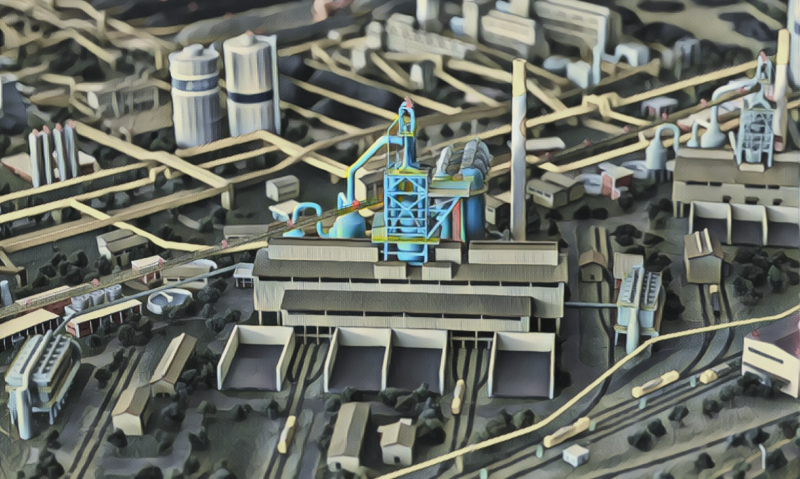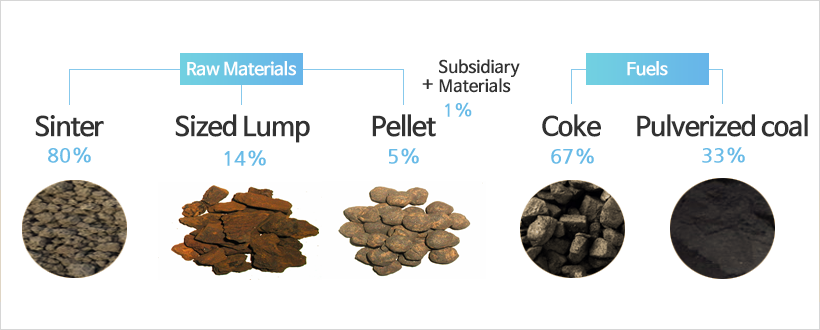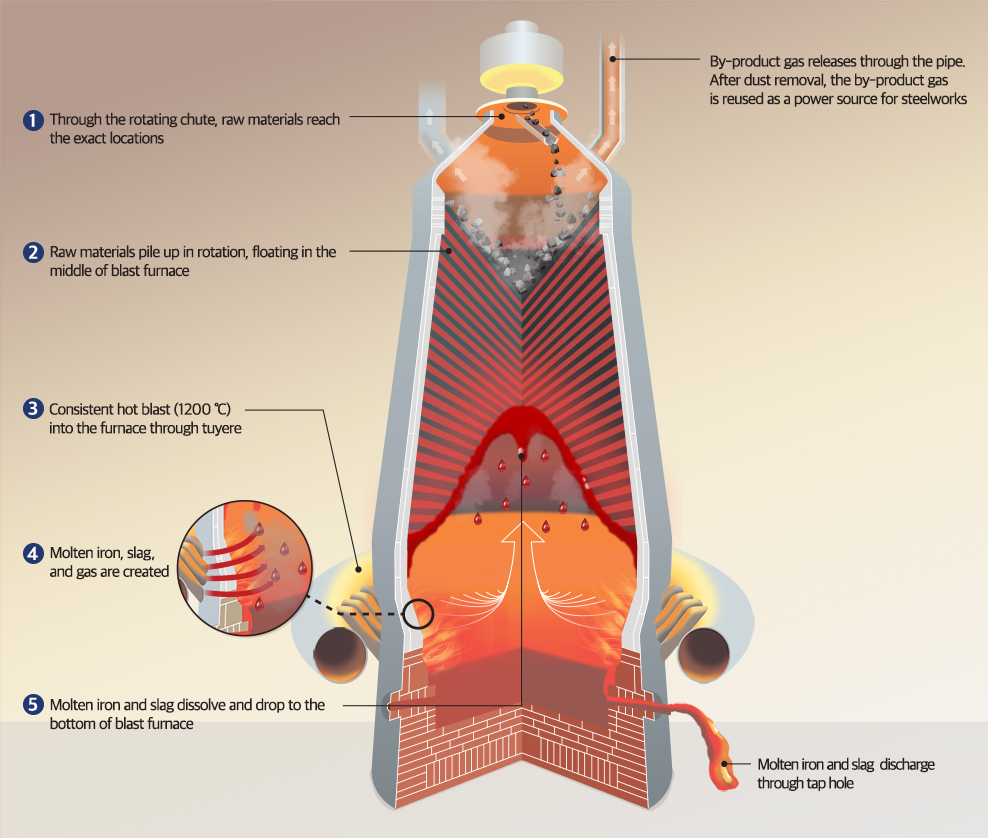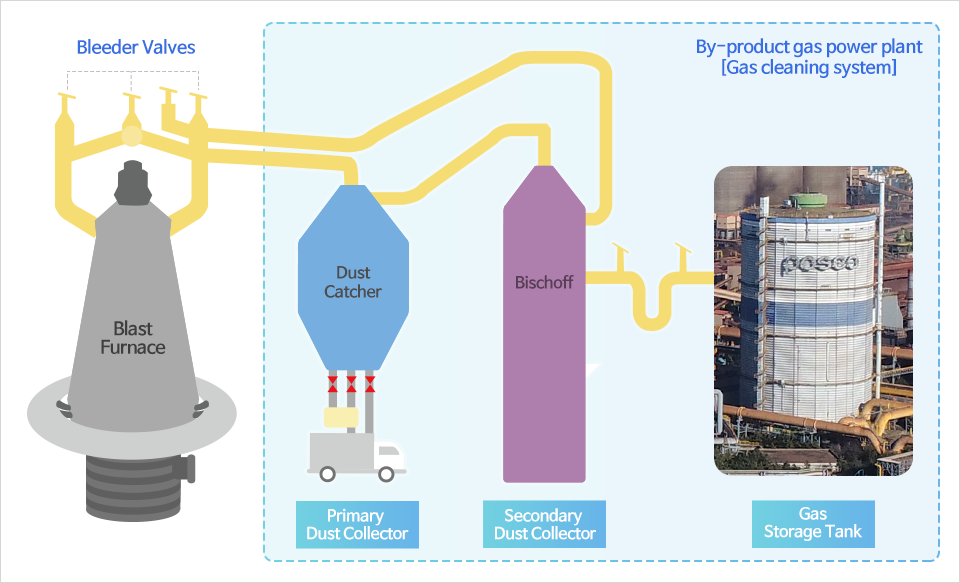POSCO operates two integrated steelworks in Korea — in Pohang, and Gwangyang, and blast furnaces are at the heart of those steelworks operation. Altogether, there are 9 blast furnaces at POSCO steelworks — four in Pohang, and five in Gwangyang. With an internal capacity of 6,000 cubic meters, the No.1 blast furnace in Gwangyang has the biggest production capacity in the world.
Blast furnace produces molten iron, and it is indispensable to steelworks operation. With 110 meters in height, its scale is enormous.
All the steel products we see in our everyday lives are made from the molten iron. However, other than this simple fact, there really isn’t much we know about the blast furnace as what’s visible is its colossal steel exterior, not the inside.
What’s inside the blast furnace and how does it operate, with what technology? To help understand the details of blast operation, POSCO Newsroom presents ‘Blast Furnace Anatomy #1 – To the Heart of Steelworks Operation.’

l Earth, Fire, and the Wind: The Three Elements of Molten Iron
What gives birth to molten iron? It’s Earth, fire and the wind — these three elements come together in a blast furnace to create molten iron. How exactly? Let’s find out.
First, the iron ore, the raw materials for steel, comes from the Earth. Most iron ores — hematite, magnetite, limonite — contain an average of 60% of iron (Fe). Before the iron ores enter a blast furnace, it undergoes ‘sintering’ which turns the pristine iron ore into more compact and appropriate sizes.
The sintered iron ores become ‘sinter.’ The iron ores that come in just the perfect size right from the extraction are called ‘sized lump.’ The ores in microscopic scales are pelletized, which are called ‘pellets.’ Steelmaking utilizes all three materials as raw materials. Subsidiary raw materials like limestones are also used.
<Blast Furnace: Fuels & Raw Materials>
Now, the blast furnace will melt all the raw materials and extract only the iron (Fe), where coke and pulverized coal fuel the raw materials.
Coke is a grey, hard, and porous fuel made by heating coal up to 1000℃. Inside the furnace, coke is the main heat source melting various materials. It also acts as a reducing agent deoxidizing iron ores. The pulverized coal is a lump of the coal smashed into small pieces — of 0.125mm in size or less. Of the two, pulverized coal makes for a more economical option.
The raw materials and fuels alone do not magically create molten iron, of course. They will need the hot air inside the blast furnace — the hot air about 1200 ℃ in temperature. Then, the fuels and raw materials layered inside the furnace literally fly up inside the furnace! To better grasp the process, let’s slice the blast furnace in half and look inside.

This is what a blast furnace looks like. What exactly happens inside the blast furnace?
Fuels and raw materials enter the furnace through the top opening. The rotating chute evenly distributes the materials, landing them precisely at the due location. Then, the fuels and raw material layer in rotation — a layer of fuel, a layer of raw material, etc. Together, they create more than 40 layers of fuels and raw materials.
At the bottom of the blast furnace, the hot air of 1200℃ heats the materials and fuels. The hot air with a force of 4.0bar triggers such a force that the materials fly up in the air. Because of the heat, coke chemically dissolves the raw materials.
These processes produce molten iron, slag, and by-product gas at which stage, they are still mixed. Then, the by-product gas rises to the top while the molten iron and slag drop to the bottom. Once filtered through dust collectors, the gas transforms as a power source for steelworks. As for slag and molten iron, they are each separated for slag granulation and steelmaking. From the moment the raw materials enter the furnace, it takes about six and a half hours for the materials to transform into molten iron.
l And By-products? Recycle, Recycle, and Recycle
The by-product gases produced inside the blast furnace are released through the top pipe, mostly carbon monoxide, carbon dioxide, and nitrogen. For every ton of molten iron produced, the furnace emits about 1,600 cubic meters of gas. The gases go through primary and secondary dust collectors for purification. The purified gases are utilized to power different facilities at steelworks. This is how POSCO self-produces 74% of the electricity for its steelworks operation.
<Blast Furnace: The Journey of By-product Gases>
Other by-products from inside the furnace also include ingredients like silica (silicon dioxide) — not part of necessary ingredients to produce molten iron. To separate silica from iron ore, the subsidiary material limestone is added during sintering. Once inside the furnace, limestone combines with the silica and drops to the floor. The mixture is lighter than molten iron, so it layers above the molten iron. This mixture is another steelmaking by-product, slag.
Where does the slag end up? POSCO slag is recycled 100% as fertilizer and cement. Blast-furnace slag is rich in silicic acid, an excellent fertilizer for rice farming. Altogether 390,000 tons of POSCO slag was used for agricultural farming in 2018.
POSCO also developed POSMENT, an eco-friendly cement with a higher portion of slag which reduces CO2 emission up to 60%. Altogether 10.69 million tons of POSCO slag contributed to reducing 8.39 million tons of net greenhouse gas emissions.
l Is Blast Furnace Outdated?
Because blast furnaces have been around for so long, it could feel outdated. However, the furnace is full of sophisticated technology.
The sophistication starts from the very moment when the raw materials drop into the blast furnace. Landing them at the precise locations requires advanced technology. Precise calculation is crucial in all procedures — the order of insertion, in what sizes, how much, where, and at what timing. Based on these calculations, the rotation angle of the chute is adjusted, so that the raw materials and fuels distribute evenly inside the furnace.
Another part of the furnace technology involves the insertion of hot air into the furnace through over 40 holes. The timing must be steady. To boost productivity, pure oxygen is sometimes added to the hot air. There is also a facility that produces the hot air, which is called a hot stove. What powers the hot stove is the by-product gas produced in the blast furnace — recycled 100%. Such sustainable technology is at the core of POSCO’s competitiveness.
With the mixtures of solids, liquids, and gases creating many chemical reactions, it can be difficult to predict exactly what’s happening inside the furnace. With the 46 years experience of operating blast furnaces, POSCO has a reliable system to predict the condition of furnaces, however. At POSCO, the condition of blast furnaces can be monitored through live-data such as the temperature of the furnace, pressure, and the status of molten iron-making. Since the blast furnace operation is 24/7 nonstop, maintaining a stable condition has a critical bearing on the safe and economical operations of steelworks.
l Blast Furnace Shapes Korea’s Modern History
It’s no wonder the Pohang No.1 Blast Furnace was cited as Korea’s economic national treasure — for the immense contribution it sparked for Korea’s overall economic growth.
During the 1960s, when the whole country was still reeling from the wounds of the war, POSCO’s blast furnace provided an opportunity not only to lift the country off abject poverty but to continue — to hope.
Even at this moment, the Pohang No.1 Blast Furnace is making molten iron just the same — like the time when the golden molten iron poured out of the tap of the Pohang No. 1 blast furnace for the first time. The initial sentiment of the time might have faded, but the blast operation continues.
